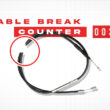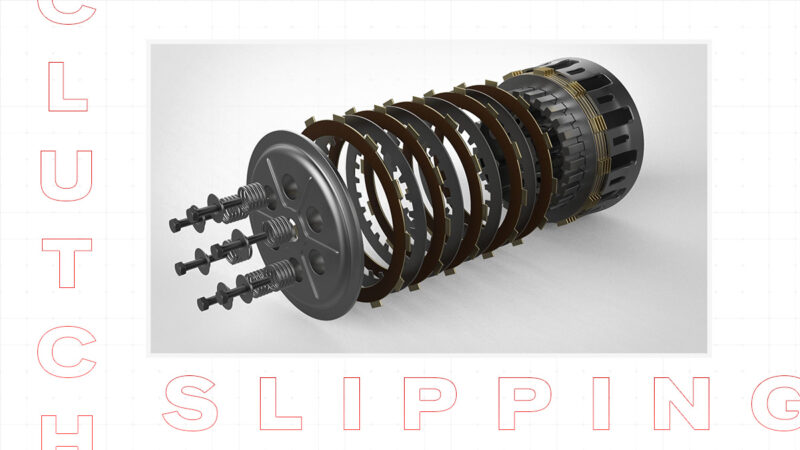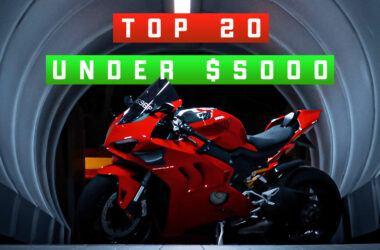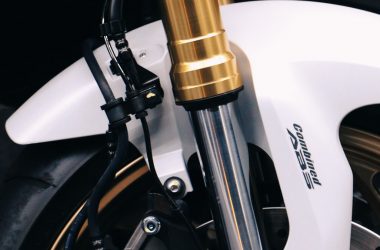Table of Contents Show
Motorcycle clutch slipping is one of the most common major problems faced by many riders all over the world and typically this issue arises in motorcycles that are frequently used/ridden. Not only does this problem affect the overall performance of the bike but also invalidates rider safety.
Motorcycle clutch slipping occurs when a distinct separation exists between the friction plates and the steel plates within the clutch pack, even when the clutch is engaged while the clutch lever is fully released. This issue can be attributed to several factors, including a tightly adjusted clutch cable, incorrect clutch lever free play, or the presence of any physical damage to the components of the clutch assembly.
For a regular person with no knowledge of a motorcycle’s mechanical functioning, it can get confusing and will have no idea how to fix a slipping clutch in their motorcycle and what are the underlying causes behind this.
In this article, we will first go through in detail about, what is a slipping clutch in a motorcycle. Then we will go through some obvious symptoms which will let you identify this issue and some major causes behind it.
Finally, we cover how to fix a slipping clutch in your motorcycle properly with step-by-step instructions and how much will it cost you approximately to fix this problem as the prices will vary from motorcycle to motorcycle.
What is a Slipping Clutch In a Motorcycle?
Slipping clutch in a motorcycle is a mechanical problem where the friction plates and steel plates of the clutch pack don’t engage together because of a distinct gap present between them.
So when you release the clutch lever for the motorcycle’s clutch to engage, the clutch will slip which will cause the motorcycle to momentarily lose power or not move at all.
Due to this problem, the power from the engine is not efficiently transmitted to the rear wheel due to the clutch not fully engaging (also known as clutch plates not coming in and sticking together ).
So now you know what a slipping clutch is also called a clutch slip and it can lead to a range of problems, from difficulty in gear shifting to an overall loss in performance.
Understanding the symptoms and causes of a slipping clutch is essential to properly fixing a slipping clutch in your motorcycle.
Motorcycle Clutch Slipping Symptoms
Now we will discuss some of the major symptoms you could expect when your motorcycle’s clutch is slipping and recognizing these symptoms will help you make better decisions on fixing/solving this problem.
1. Clutch Slipping At High RPM
If your motorcycle has a slipping clutch you could notice at higher rpm while changing gears your motorcycle clutch will slip.
This happens due to physical damage to the parts of the clutch assembly or improper clutch cable adjustment resulting in clutch plates not being able to engage at high rpm.
As you know the clutch plates rotate along with the clutch housing to transfer power to the transmission and then to the rear wheel.
The rotating speed of the clutch housing and clutch plates will be higher at high rpm, so a sudden loss of power caused by a clutch slip can be dangerous.
2. Motorcycle Clutch Slipping When Accelerating
Clutch slip during accelerating whether you are at low rpm or high can be recognized with an erratic throttle response where you might notice a lack of power or no power when accelerating for a couple of seconds.
If the clutch slips every time you accelerate then you should get it fixed immediately to avoid any severe damage to the parts of the clutch assembly.
3. Difficulty Shifting Gears
One of the primary symptoms of a slipping clutch is difficulty in shifting gears smoothly.
You may find it hard to change gears which can often result in miss shifts or false neutrals.
A jerky and inconsistent gearshift causes a lot of difficulties and an unpleasant riding experience.
4. Unusual Grinding Noises
A slipping clutch can produce unusual grinding or squeaking noises, especially when you’re engaging or disengaging the clutch lever.
These sounds indicate friction plate or steel plate damage. Notching or grooving of the clutch basket or inner hub will cause the clutch pack to get stuck momentarily will can create a metallic grinding noise while shifting gears
5. Motorcycle Not Moving Forward
If you release the clutch lever, but your motorcycle doesn’t move forward as expected, it’s a clear sign of a slipping clutch.
The engine’s power is not transferring effectively to the wheels due to the friction plates and steel plates of the clutch pack are not completely compressed together leaving a small gap between them.
This causes the clutch basket and the inner hub to not rotate simultaneously resulting in a power cutoff to the transmission and rear wheel.
6. Harsh Gearshifts
Shifting gears might become harsh and abrupt due to a slipping clutch. This can be frustrating and may lead to gear-related issues over time.
Not fixing this as soon as possible will lead to permanent damage.
Motorcycle Clutch Slipping Causes
1. Damaged Clutch Basket Fingers
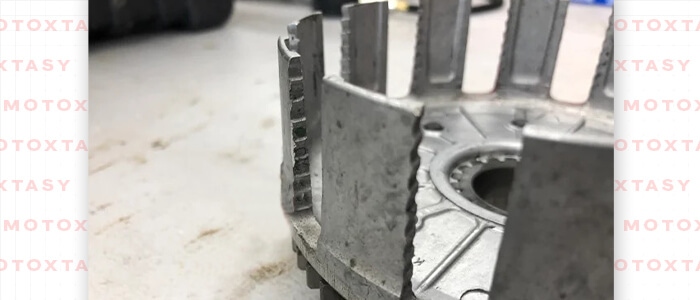
A clutch basket also called clutch housing holds the friction plates and steel plates with the help of the inner hub in their place.
The friction plates of the clutch pack interlock with clutch basket fingers to generate and transfer power to the wheel when the clutch lever is released.
Notching or grooves/indentations on the clutch basket fingers cause the friction plates get to stuck and not move smoothly while the clutch is engaging or disengaging.
Friction plates getting stuck will create space between steel plates and friction plates resulting in motorcycle clutch slipping.
2. Worn/Damaged Clutch Inner Hub Teeth
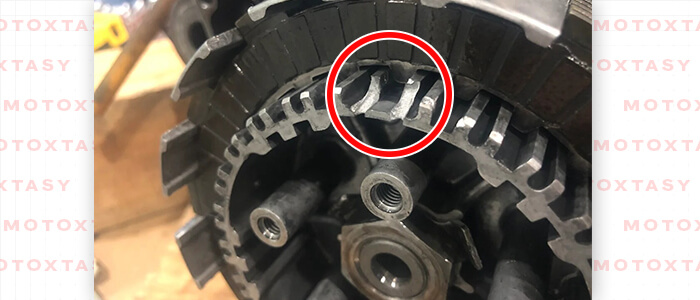
The clutch inner hub is located inside and in the center of the clutch basket and is a part of the clutch housing.
The inner hub holds the steel plates in place and engages and disengages them when the clutch lever is pulled or released just like the friction plates do with friction plates.
If the clutch inner hub teeth are damaged and have signs of chipping, notching/grooves, then the steel plates will get stuck causing the clutch to slip.
To successfully transfer power to the rear wheel of the motorcycle, the friction plates and steel plates should be compressed together when the clutch lever is released which fully engages the clutch.
Damage to the inner hub or clutch basket fingers will cause the clutch plates to get stuck which will create a space between causing the motorcycle clutch to slip.
3. Tight Clutch Cable Adjustment
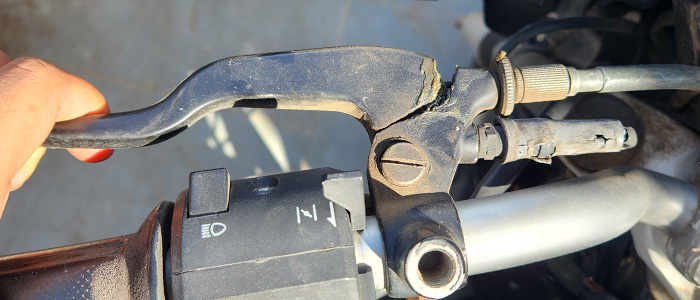
If the clutch cable is adjusted on a tighter side it will not let the clutch get fully engaged even when you completely release the clutch lever.
This will result in the clutch still being disengaged to an extent that causes a power cut-off to the rear wheel resulting in the motorcycle not moving forward effectively.
You will experience jerky movement and momentary power cut-off here and there but if the clutch cable is super tight and wrongly adjusted, then this will cause unnecessary friction between the clutch plates and harsh gearshifts.
4. Wrong Actuator Arm & Clutch Lever Free Play
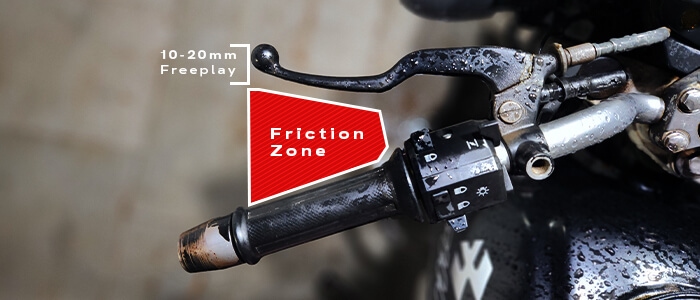
Adjusting the clutch lever free play and the clutch cable slack goes hand in hand, and having the right amount of free play at the clutch lever and at the actuator arm which sits on the top of the clutch cover will automatically adjust the clutch cable properly.
Generally, it is advised to have a clutch lever free play of 10-20mm if you are measuring it from the end of the clutch lever to the handlebar.
And if you are installing an aftermarket clutch lever which is often smaller in length compared to your originally manufactured clutch lever, then it is advised to have a free play of 2-4 mm from the start of the clutch lever.
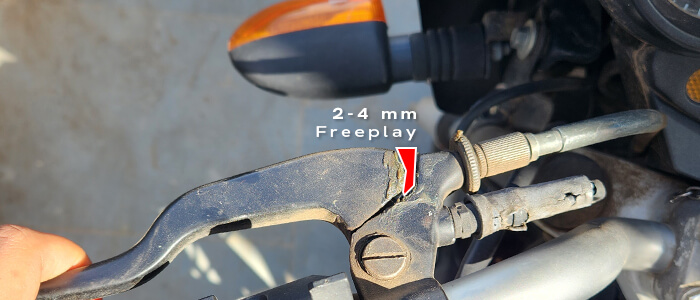
For the actuator arm where the other end of the clutch cable connects, it is advised that the actuator arm should be directly perpendicular to the clutch cable’s end creating a perfect 90-degree right angle with a little amount of free play (1-2cm).
It’s essential to maintain the correct amount of free play to ensure the clutch functions correctly.
5. Damaged Steel Plates and friction Plates
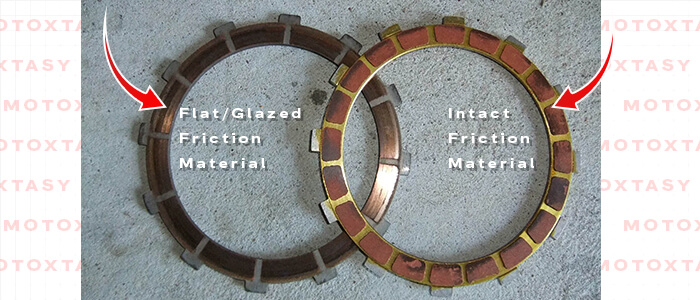
Worn or damaged steel plates and friction plates are common culprits behind clutch slipping.
A damaged or worn friction plate will have little to no friction material left on it. Other signs of damage may include chipping of teeth on the outer circumference of friction plates.
Worn or damaged steel plates will have signs of bending or chipping of their teeth on the inner circumference.
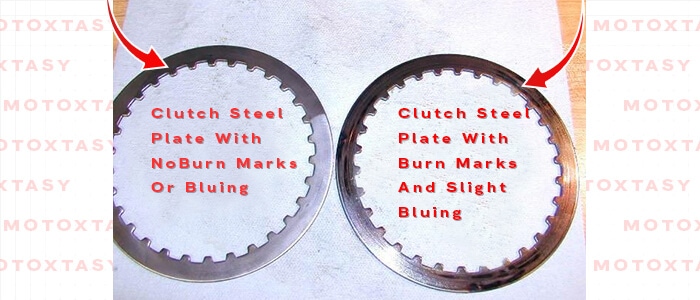
Bluing or burn marks on the steel plate also indicate that they are severely worn. Over time, these components can become thin or warped, reducing their effectiveness.
These damages will cause the clutch plates to engage or disengage properly resulting in motorcycle clutch slipping.
6. Damaged Clutch Springs
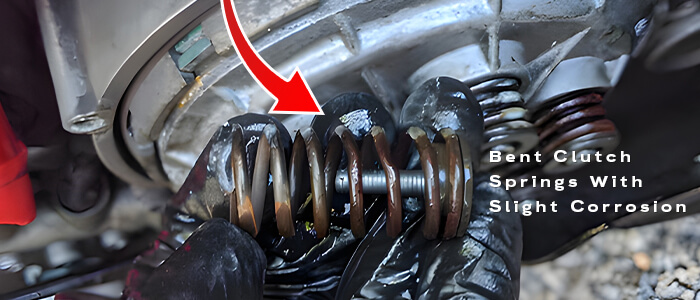
Clutch spring damages may include corrosion or bending which can lead to an insufficient amount of pressure needed to compress or decompress the clutch pack.
Weak or damaged clutch springs can cause the clutch to remain disengaged even when you release the lever.
So any kind of physical damage to the clutch spring will cause the motorcycle’s clutch to slip.
7. Pressure Plate Losing Tension
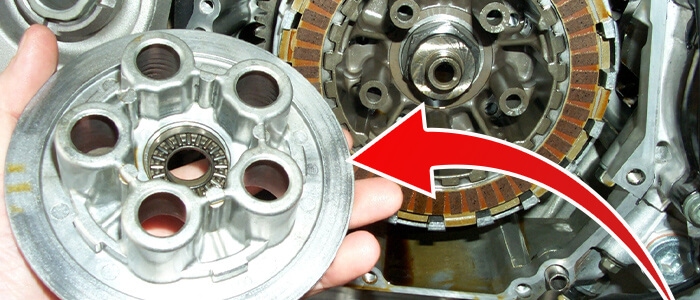
The pressure plate goes on top of the clutch pack and is held in its place by a set of clutch bolts.
The clutch springs along with the pushrod push the pressure plate outwards when you pull in the clutch lever to disengage the clutch.
So when you release the clutch lever for the clutch to engage, the pressure plate returns to its original position where the clutch pack is fully compressed which successfully transfers power from the clutch to the rear wheel.
Corroded clutch bolts or damage to the bolt threads will cause the pressure plate to lose tension, which will result in the clutch not fully engaging causing it to slip.
8. Seal Leak Of Master Or Slave Cylinder
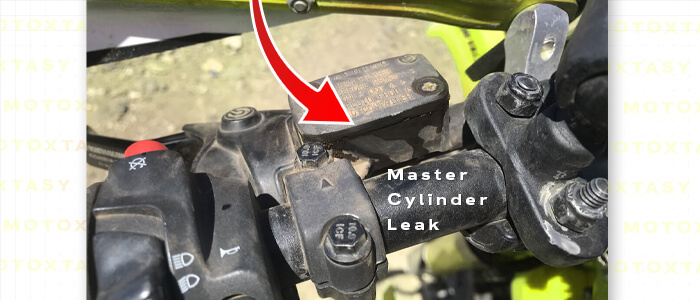
For motorcycles with a hydraulic actuated clutch system, master and slave cylinders are used to engage and disengage the clutch.
Clutch fluid in the master and slave cylinder is used for compression and decompression of the clutch plates while pulling in or releasing the clutch lever.
If the seal of the master cylinder or slave cylinder is broken, then it will introduce air into the clutch system causing it to lose its pressure which will result in a spongy clutch lever, clutch drag, or clutch slip.
9. Not Bleeding Hydraulic Clutch System
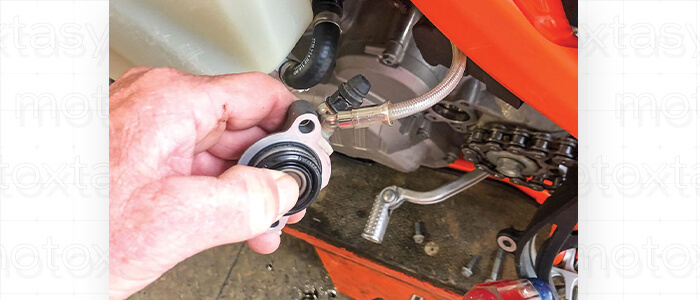
Bleeding the clutch system is a process of removing all clutch fluid and air from the system before it’s ready to use.
In motorcycles with hydraulic clutch systems, improper bleeding can lead to air pockets that prevent the clutch from fully engaging which will result in clutch slipping.
10. Low Level Of Clutch Fluid
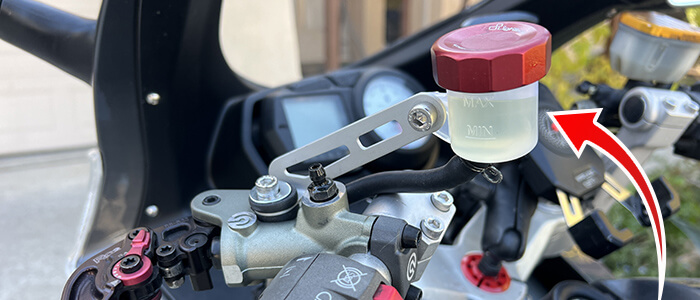
Low clutch fluid can result in inadequate hydraulic pressure, causing the clutch to slip.
Regularly check and maintain the clutch fluid level of the master cylinder for a properly working clutch in motorcycles with hydraulic actuated clutch.
How Can I Tell If My Motorcycle Clutch Is Slipping?
A quick way to know if your motorcycle clutch slips is by accelerating and observing if the motorcycle moves forward smoothly or stalls in a place.
A slipping clutch in a motorcycle will always either stall the motorcycle or will have no power output even when you accelerate/roll the throttle.
So by following this process, you will figure out if your motorcycle clutch is slipping or not.
What Happens If You Keep Riding With A Slipping Clutch?
Continuing to ride your motorcycle with a slipping clutch will put pressure and cause friction on the clutch assembly parts such as the clutch basket, inner hub, and clutch plates which will lead to further severe damage and costly repairs.
So it is advised to fix the slipping clutch in your motorcycle before you start riding again.
How Do You Fix A Slipping Clutch In Motorcycle?
Generally, if your motorcycle has a slipping clutch it is due to worn or damaged parts of the clutch assembly which need to be replaced for the clutch to function properly.
Here’s a step-by-step procedure to fix a slipping clutch in your motorcycle.
- First, loosen the clutch cable and uninstall it if it’s connected to the top of the clutch cover.
- After uninstalling the clutch cable, drain the engine oil completely.
- Remove the clutch cover bolts and place them on a dry clean surface.
- Take off the clutch cover and clutch gasket carefully.
- Now unscrew the clutch springs bolts and remove the pressure plate.
- Now remove the friction plates and steel plates of the clutch pack one by one and inspect for any physical damages.
- Stack the clutch plates in order when you remove them to make the reassembling process of the clutch plates easier.
- Now look for any signs of damage or wear on the clutch plates such as glazed friction material of the friction plates or bluing or bending of the steel plates.
- Also, look for notching, chipping, or deep grooves on the clutch basket fingers or inner hub.
- Soak the new clutch plates in engine oil for at least one hour before installing them.
- Install the new clutch plates in the same order when you removed the old ones or use your motorcycle’s service manual for reference.
- Replace the clutch basket or inner hub if necessary by removing the center hexagonal nut to set them free.
- After installing the new clutch plates in the correct order, put back the pressure plate on top of the clutch pack.
- Screw back on the clutch spring bolts on the pressure plate to the right torque. (You can use a service manual to find your motorcycle’s specific spring bolts torque figures)
- Use a new clutch cover gasket to avoid any seal leakage.
- Finally, put back on the clutch cover and tighten the clutch cover bolts.
Replacing the worn/damaged clutch plates, clutch basket, or inner hub will stop the motorcycle clutch slipping problem.
Be sure to adjust the clutch cable correctly with the right amount of clutch lever free play to avoid any additional clutch engagement or disengagement problems.
Metal filing the grooves on the clutch basket fingers is a temporary fix, but it is safer to replace the damaged clutch basket or inner hub to avoid any sudden and severe damage to the clutch assembly.
How Much Does It Cost To Fix A Slipping Clutch?
The cost varies based on factors like the motorcycle model, the extent of damage, and labor costs.
Repairs can range from a few hundred dollars to over a thousand. Regular maintenance can help prevent costly clutch issues.
Conclusion
In conclusion, a slipping clutch can significantly affect your motorcycle’s performance and safety. Understanding the symptoms and causes is the first step in addressing the issue.
Regular maintenance, proper adjustment, and timely repairs are essential to keep your motorcycle’s clutch in top condition.
Don’t ignore the signs of a slipping clutch, as early intervention can save you time and money in the long run.


